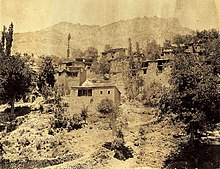

Baz (Syriac: ܒܙ) was one of the five independent Assyrian tribes of the Hakkari region.
History
Maha Khtayya was the chief village of the region, followed by Shwawwa.
The Assyrians of the Baz tribe were renowned carpenters and iron-workers who worked not only in their villages, but throughout Mosul and other large towns of Upper Mesopotamia.
Assyrian Villages in Baz, Turkey
The Assyrian settlements that traditionally comprised the Baz region in Hakkari consist of the following villages. The region has been empty since they were abandoned in 1915 due to the Assyrian genocide.
- Arwantus (Artusnaye)
- Shwawwa (Shawutnaye)
- Maha Khtayya (Mahaye) (37°27 N, 43°53 E)
- Be-Selim (Selimnaye)
- Argab (Argabaye)
- Kojij (Kojijnaye)
Current Baznaye settlements
These are the villages occupied after the Baznaye were resettled by the British in 1920s and the French in the 1930s.

- Babilo (Shawutnaye)
- Bagereh (Selimnaye)
- Chaqala (Kojijnaye)
- Sardarawa (Artusnaye)
- Sorka (Mahaye)
- Simele (Mahaye)
- Badarrash (Artusnaye)
- Sarsing (Artusnaye)
- Sikren (Selimnaye)
- Sedar (Shawutnaye)
- Pirozawa (Argabaye)
- Ain Sifni (Mixed Baznaye)
- Mawana (Mixed Baznaye)
- Tell Baz (Shawutnaye, Mahaye and some Argabaye)
- Tell Ruman Foqani (Selimnaye and Mahaye)
Famous people
- General Agha Petros Elia - Assyrian military leader during World War I and Chief Negotiator for the *Assyrian/Chaldean/Syriac people during the 1920s.
References
- Wilmshurst, David (2000). The ecclesiastical organisation of the Church of the East, 1318-1913. University of Virginia: Peeters. p. 285. ISBN 9782877235037.
- ^ Mutzafi, Hezy (2000). "The Neo-Aramaic dialect of Maha Khtaya d-Baz. Phonology, morphology and texts". Journal of Semitic Studies. 45: 293, 294. doi:10.1093/jss/45.2.293.
- Maunsell, F.R. (1901). "Central Kurdistan". The Geographical Journal. 18 (2): 138. doi:10.2307/1775333. JSTOR 1775333.
- Ainsworth, William (1841). "An Account of a Visit to the Chaldeans, Inhabiting Central Kurdistan; And of an Ascent of the Peak of Rowandiz (Tur Sheikhiwa) in Summer in 1840". Journal of the Royal Geographical Society of London. 11: 35. doi:10.2307/1797632. JSTOR 1797632.
- ^ Dodge, Bayard (1 July 1940). "The settlement of the Assyrians on the Khabbur". Journal of the Royal Central Asian Society. 27 (3): 314. doi:10.1080/03068374008730969. ISSN 0035-8789.
- Fernandez, Alberto M. (1998). "Dawn at Tell Tamir: The Assyrian Christian Survival on the Khabur River" (PDF). Journal of Assyrian Academic Studies. 12 (1): 41, 42. Archived from the original (PDF) on 2016-08-28. Retrieved 2020-04-25.
- Fernandez, Alberto M. (1998). "Dawn at Tell Tamir: The Assyrian Christian Survival on the Khabur River" (PDF). Journal of Assyrian Academic Studies. 12 (1): 41, 42. Archived from the original (PDF) on 2016-08-28. Retrieved 2020-04-25.
38°01′N 44°06′E / 38.017°N 44.100°E / 38.017; 44.100
Categories: